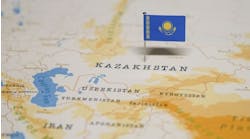Petrocom, a Gulf of Mexico cellular and microwave communications provider, is planning to create a fiber-optic ring to aid communications in the Gulf of Mexico. The high capacity of FiberWeb will provide capability for not only reliable voice communications, but video, cable television, and the Internet from platform to platform or platform to onshore.
The fiber-optic cable, which will have capability of 2.5 gigabytes per second initially, will run in a rough oval onshore from Freeport, Texas, up to Houston, and across to New Orleans, down to Fourchon, Louisiana, then offshore south and westward to Freeport. In the initial phase, the loop will connect six offshore platforms.
Work on the onshore portion has been ongoing for some time. The Maersk Forwarder will begin laying the cable offshore around June 20.
Petrocom acquired the use of two decommissioned pipelines at its landfall points. One, formerly owned by Enron, is a 8-in. line extending offshore Freeport about 10 miles. The other is a 6-in. line, formerly owned by Burlington Resources, that extends about five miles offshore Fourchon. The cable will be protected by being laid in these lines.
Then, the Maersk Forwarder will lay the remaining cable between the two points with connections at platforms on East Breaks 160, Garden Banks 236, South Marsh Island 205, Green Canyon 19, South Timbalier 165, and Mississippi Canyon 268. Another vessel will bury the line three feet deep out to a water depth of 300 ft, where the cable will be simply laid on the seafloor.
FiberWeb will be a synchronous optical network (SONET) ring. SONET is a fiber optic transport standard which allows bi-directional signal transmission, allowing communication to continue even if the cable is severed. For example, if there were a break in the cable between East Breaks 160 and Garden Banks 236, the signal would be routed backwards around the loop (counterclockwise from GB 236, clockwise from EB 160), eventually reaching its intended goal. This adds greater reliability to the current alternatives (cellular, microwave, satellite), which may not be available or consistent in those areas. Because of the bi-directional quality of the lines, a single break will not be a stumbling block to communication. However, two breaks at once will effectively strand whatever's in the middle.
Petrocom believes it is quite likely that the cable will be severed during the course of normal operations in the nearshore area - which includes shrimp trawling. It intends to educate users of the area about the line and where it will run. It also intends to award a standby contract to a service company to repair the line, once severed. No contract has yet been awarded, but Petrocom is talking to several companies.
Petrocom intends to provide both wholesale and retail services with FiberWeb. It will lease simple bandwidth for some users, and work with companies to provide specific services in others.
Reliable high-quality high-bandwidth communication could revolutionize some parts of the offshore industry in the Gulf of Mexico. Telephone access would be the least of it. Video conferencing is now available using satellite communications, but Petrocom says it will provide more reliable service. Real-time data from seismic work, wireline operations, and measurement while drilling can be transferred and examined at company headquarters onshore. More tasks could be automated, with control from practically anywhere. Regulatory reporting could occur in real time. Internet access, should be fast and reliable. Cable television programming will be available for entertainment.
In the future, more platforms may be added to the ring. One proposed spur in the second phase would connect Exxon's Diana and Hoover developments, though that has not been agreed upon as yet. It is planned that the ring be operational by August.


